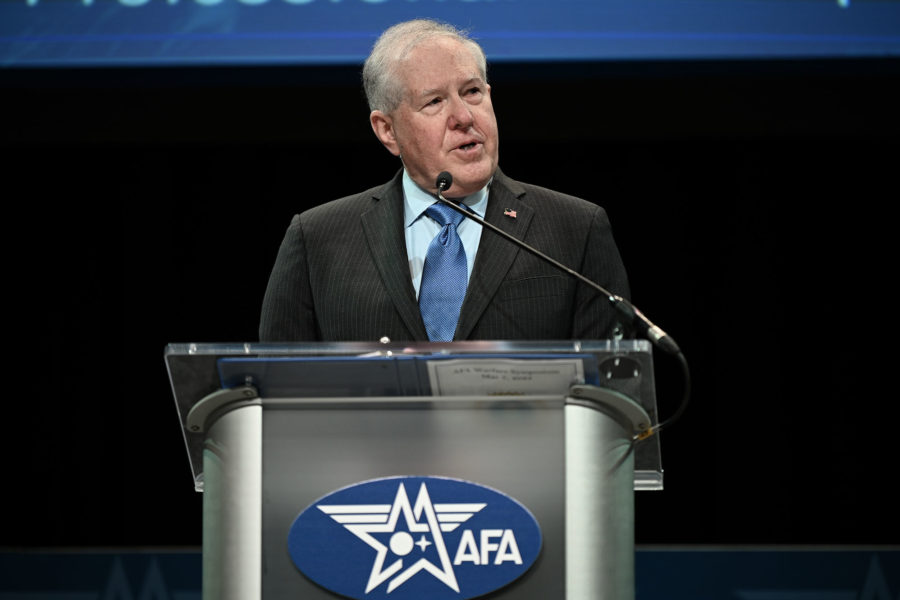AURORA, Colo.—The Air Force will field 200 Next-Generation Air Dominance aircraft and notionally 1,000 Collaborative Combat Aircraft, and will request funds in the fiscal 2024 budget to develop these new systems, Secretary Frank Kendall said in his keynote address at the AFA Warfare Symposium on March 7.
The next generation of air dominance will include both the Next-Generation Air Dominance fighter platform “and the introduction of uncrewed collaborative aircraft to provide affordable mass and dramatically increased cost effectiveness,” Kendall said.
The “notional” 1,000 CCA figure was derived from “an assumed two CCAs for 200 NGAD platforms, and an additional two for each of 300 F-35s,” Kendall said.
He cautioned that “this isn’t an inventory objective, but a planning assumption to use for analysis of things such as basic organizational structures, training and range requirements, and sustainment concepts.”
Exactly how many NGAD platforms the Air Force is planning to buy has been a closely-held secret, and even if it is “notional,” the 200 figure is revealing in that it is greater than the current inventory of F-22s which the NGAD will eventually succeed circa 2030.
Kendall has previously said as many as five CCAs could collaborate with each crewed fighter—performing missions in electronic warfare, suppression of enemy air defenses, air and ground protection, and communications—but he has also said the process of introducing them will be iterative.
Asked in a later press conference why the planning figure mentioned 300 F-35s—when the Air Force inventory objective of 1,763 F-35s has not changed since the program’s inception—Kendall said it is “just a reasonable starting point. It’s somewhat arbitrary.”
While USAF is “starting out” with a notional two CCAs to work with each of 500 fighters, “I don’t know what the ultimate inventory … would be or exactly what the ratio would be,” Kendall said. “It could be more than that. It’s going to be a question of what the technology will support and what works out best for operational forces. But we wanted to give” chief of staff Gen. Charles Q. Brown, Jr. “a reasonable assumption, … a basis to begin some planning.”
He added that, “This is a new thing. It’s a … way of operating we haven’t actually had a experience with, so we’ve got a lot to learn and that’s going to take some experimentation … some testing and some careful thought. So we put that on the table as a way to structure that planning, around what we think is a reasonable first tranche and a reasonable ratio. And we’ll learn as we go.”
Kendall said the budget that will go to Capitol Hill next week will include requests for CCA stand-ins “that … are not the ultimate CCA, which we can use for a variety of things to develop operational concepts to develop technology, reduce the risk of the program … and also start to think through some things like how we train, what kind of organizational structures we have, etc. So there’s still a lot to be done there.”
Kendall acknowledged his earlier comments about up to five CCAs per crewed aircraft, but said the updated figure of two is about finding a “sweet spot.”
“We don’t want to undershoot, we don’t want to overshoot,” Kendall added. While the Air Force wants to get “as much operational combat capability as we can out of this concept,” he warned that “if we shoot too far, we’re gonna have a problem: program that gets caught in schedule and cost overruns. So we’re assessing the technology.”
The CCAs will be pursued “competitively,” he told reporters. “There are a lot of candidates. … People are out there thinking hard about this already, based on the what we’ve already put out.”
“I want to push the technology without pushing it too far. So that’s that’s something we’re gonna have to figure out as we go along,” Kendall added.
Affordability for force-building is one of the drivers behind the push for CCAs, Kendall said—if the Air Force only buys F-35s and F-15EXs, then “we have an unaffordable Air Force.” The goal for CCAs will be to cost “some fraction” of the cost of an F-35. “We’re going to design around that,” he said.
However, Kendall also hinted that greater buys of F-35s will be coming in the fiscal 2024 budget request that goes to Congress in the next week or so, saying in his speech that the service “will be acquiring aircraft currently in production at higher rates than previously planned,” though, in general, “our previously-initiated programs are continuing as intended.”
In the longer term, the 2024 budget includes “close to 20 new or significantly enhanced efforts.”
Kendall said his “greatest fear” is that Congress will not move out quickly to debate, authorize, and appropriate defense funds, which would stymie new starts and be “a gift to China … that we cannot afford.”
Quoting Gen. Douglas MacArthur, Kendall said “military failure can almost always be summarized in just two words: ‘Too late.’ Time is an asset that can never be recovered or replaced.” And while he expressed gratitude to the White House and Congress for supporting increased USAF spending in fiscal 2023, “especially in allowing nearly all requested divestitures of legacy systems,” he also warned the forthcoming budget request will include more “hard choices.”
